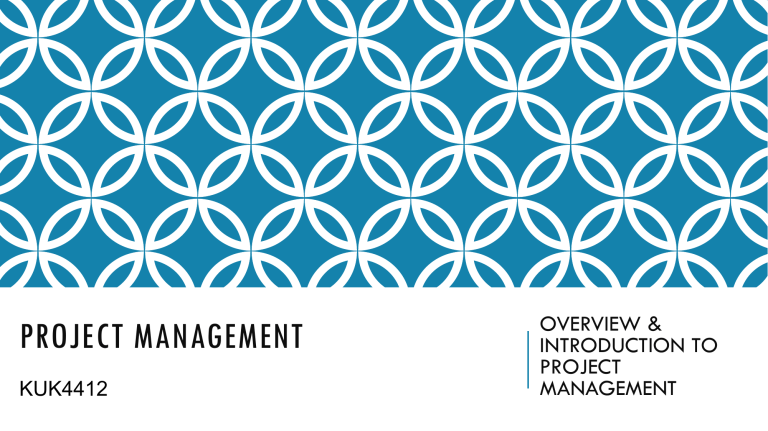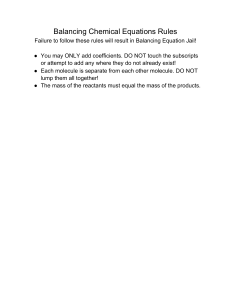
PROJECT MANAGEMENT KUK4412 OVERVIEW & INTRODUCTION TO PROJECT MANAGEMENT TOPIC OUTLINE 1. Overview of project management 2. What is a project? 3. What is project management? 4. Project life cycle 5. Triple constraints 2 LESSON OUTCOMES LO1 Describe what project and project management is LO2 Identify the different stages of product life cycle LO3 Recognise means of balancing the product constraints 3 OVERVIEW OF PROJECT MANAGEMENT o Organizations with worldwide impact on the practice of project management: 1. Project Management Institute (PMI) - United States 2. International Project Management Association (IPMA) – Switzerland Project Management Institute (PMI) ▪ Founded in 1969. ▪ Non-profit PM professional association. ▪ Most widely recognized organization in promoting PM best practices. ▪ Premise - tools and techniques of PM are common among the widespread application of projects from the software to the construction industry. ▪ Fist offering the Project Management Professional (PMP) certification exam in 1984. ▪ PM discipline has evolved into a working body of knowledge (PMBOK). ▪ A Guide to the Project Management Body of Knowledge (PMBOK Guide) introduced in 1987. ▪ To provide framework for managing project and keep PM terms and concepts clear and consistent. 4 REASONS FOR PROJECT PROFESSIONALS JOINING PMI 1. Download the PMBOK® Guide for free 2. Save money on globally recognized certifications and more 3. Master new skills through free webinars and events 4. Stay ahead of deadlines using 1,000+ free tools and templates 5. Join PM community to make local and global connections 5 10 PMBOK KNOWLEDGE AREAS ▪ Fundamental knowledge needed for managing a project are categorized into 10 knowledge areas: 1. Project Integration Management 2. Project Scope Management 3. Project Schedule Management 4. Project Cost Management 5. Project Quality Management 6. Project Resource Management 7. Project Communications Management 8. Project Risk Management 9. Project Procurement Management 10.Project Stakeholder Management 6 WHAT IS A PROJECT? Project = ➢ Attempt / effort to accomplish a specific objective through a unique set of interrelated tasks & the effective utilization of resources. Project Defined ➢ A complex, non-routine, one-time effort limited by time, budget, resources, and performance specifications designed to meet customer needs. 7 Characteristics of A Project • A project is a temporary effort, which has a defined: life span/time - start and end, task durations, dependencies, etc money - costs, contingencies and profit resources - staff, equipment, material scope/performance specifications - size, goals, requirements • Has an established objective. • Requires across-the-organizational and stakeholders participation. ▪ sponsors and funding body, customer and suppliers, HSE/environmental agency • Involves doing something never been done before. • Single unit and many related activities • Difficult production planning and inventory control • General purpose equipment and require high labour skills 8 EXAMPLE OF PROJECTS Developing & introducing a new product Hosting a conference Designing and implementing a computer system Designing & producing a brochure Building a shopping mall Hosting a dinner for 20 relatives Organizing a community festival Apple’s new iPhone hits the market Hospital restructuring and Upgrading information system 9 COMPARISON OF ROUTINE WORK WITH PROJECTS Routine, Repetitive Work Taking class notes Daily entering sales receipts into the accounting ledger Responding to a supply-chain request Routine manufacture of an Apple iPod Attaching tags on a manufactured product Projects Writing a term paper Setting up a sales kiosk for a professional accounting meeting Developing a supply-chain information system Designing an iPod that is approximately 2 X 4 inches, interfaces with PC, and stores 10,000 songs Wire-tag projects for Wal-Mart 10 CRITERIA TO DETERMINE IF IT IS A PROJECT Criteria Projects are unique. Projects are temporary in nature. Assessment Is it unique? Does the product have a limited timeframe? Is there a way to determine when the project is completed? Projects are completed when the project goals are achieved. Is there a way to determine stakeholder satisfaction? 11 PROJECTS VERSUS PROGRAMS VERSUS PORTFOLIOS Program Defined A series of coordinated, related, multiple projects that continue over an extended time and are intended to achieve a goal. A project may or may not be part of a program but a program will always have projects. Centralized coordinated management of a program to achieve the program’s strategic objective and benefits. Focuses on the project interdependencies and helps to determine the optimal approach for managing them. A higher level group of projects targeted at a common goal. 12 Portfolio Defined Collection of projects or programs and other work that are grouped together to facilitate effective management of that work to meet strategic business objective. Centralized management of one or more portfolios [identifying, prioritizing, authorizing, managing and controlling projects, programs and other related work to achieve strategic business objectives]. Enables wide planning and resource allocation -intense competition internally with regard to financing / staffing projects. Balance risks across all projects. Improves communication and supports agreement on project goals. Consistent and align with organizational strategies. Example: Tanah Makmur Berhad Portfolios – plantation & property development. Programs: plantation – oil palm plantation, palm oil mill property development – KotaSAS residential and commercial properties. Projects: oil palm plantation – 13 plantation estates property development – homes, commercial complex, community centres etc. 13 WHAT IS PROJECT MANAGEMENT ? The art of directing and coordinating human and material resources throughout the life of a project by using modern management techniques to achieve the pre-determined objectives of scope, cost, time, quality and participant satisfaction. 1. Project Management includes work processes of initiate, plan, execute, control and close out (Project Life Cycle) 2. The processes involved: ▪ Scope, ▪ Quality, ▪ Cost and ▪ Schedule (Project Objectives) 14 MANAGEMENT OF PROJECTS The technical dimensions of the projects management process includes: 1. Planning - goal setting, defining the project, team organization 2. Scheduling - relates people, money, and supplies to specific activities and activities to each other 3. Controlling - monitors resources, costs, quality, and budgets; revises plans and shifts resources to meet time and cost demands 15 CHALLENGE OF PROJECT MANAGEMENT The Project Manager: Manages temporary, non-repetitive activities and frequently acts independently of the formal organization. o Is linked directly to the customer interface. o Provides direction, coordination, and integration to the project team. o Is responsible for performance and success of the project. Must induce the right people at the right time to address the right issues and make the right decisions. 16 IMPORTANCE OF PROJECT MANAGEMENT Factors leading to the increased use of project management: o Compression of product life cycle o Global competition o Increased customer focus o Knowledge explosion o Corporate downsizing o Small projects that represent big problems 17 PROJECT LIFE CYCLE Initiating Planning Performing Closing 18 Project Life Cycle Effort 19 Project Life Cycle Effort Projects are identified & selected. They are authorized using Project Charter. CHAP 2, 3 Includes: define project scope, identify resources, developing budget & schedule, identify risk = Baseline Plan. Project plan is executed & activities are carried out to produce all the project deliverables & project objectives. Project progress is monitored & controlled. CHAP 4, 5, 6, 7, 8 Evaluate project, document & identify lessons to improve on future projects. CHAP 8 20 TRIPLE CONSTRAINTS • Addressing the various needs, concerns and expectations of the stakeholders as the project is being planned and carried out • Balancing the competing project constraints; – Scope - Costs/Budget – Quality - Resources – Schedule - Risks 21 PROJECT SCOPE – A SAMPLE 22 BALANCING PROJECT CONSTRAINTS The accomplishment of project objective are constrained by many factors: Scope Quality Schedule Budget Resources Risks Customer Satisfaction Successfully completing the project requires finishing the scope of work within budget, within time frame, while managing resources utilization, meeting quality specifications and managing risk – while assuring customer satisfaction. 23 BALANCING PROJECT CONSTRAINTS 1. Project Scope All the work that must be done to produce all project deliverables, satisfy the customer that the deliverables meet the requirements and accomplish project objective. 2. Quality The project work scope must be accomplished in a quality manner and meet specifications. 24 BALANCING PROJECT CONSTRAINTS 3. Schedule The timetable that specifies when each task or activity should start & finish in order to meet the project completion date. 4. Budget The amount the sponsor / customer has agreed to pay for acceptable project deliverables. 25 BALANCING PROJECT CONSTRAINTS 5. Resources Are needed to perform the project tasks & accomplish the project objective. Resources – People, materials, equipment, facilities and many more. 6. Risk There could be risks that adversely affect accomplishing the project objective. 26 BALANCING PROJECT CONSTRAINTS 7. Customer Satisfaction It’s the responsibility of the project manager to ensure the customer is satisfied. Requires ongoing communication with customer to keep them informed and determine whether expectations have changed. 27 Q: How to ensure Project Objectives will be achieved? Factors Constraining Project Success 28 Q: How to ensure Project Objectives will be achieved? A: Develop a plan before starting the project work Factors Constraining Project Success 29 BALANCING PROJECT CONSTRAINTS Unforeseen disruption on project objective with respect to scope, budget, or schedule: The cost of some of the materials is more than originally estimated. Weather causes a delay. Additional redesign and modifications are required to meet performance specifications. Delivery of a critical component is delayed several months. A key project team member with unique technical knowledge decides to retire. 30 Q: How to ensure Project Objectives will be achieved? A: Good planning & communication can prevent problems from occurring / minimize their impact if they do occur. Factors Constraining Project Success 31 Q&A THANK YOU 32

